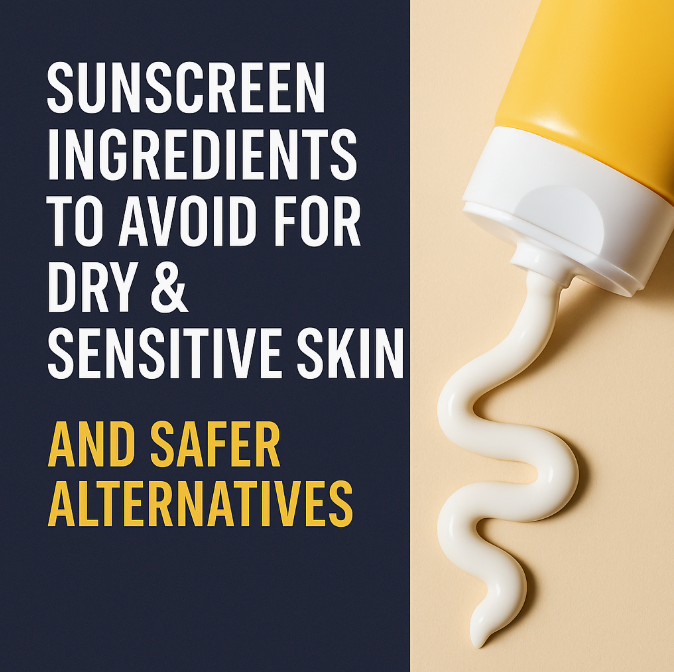
Understanding the Needs of Dry and Sensitive Skin
Having dry and sensitive skin is more than just an occasional inconvenience—it’s a daily balancing act. These skin types are prone to flakiness, redness, and irritation, making the wrong products a recipe for discomfort. One critical area that often gets overlooked is sun protection. Not all sunscreens are safe for delicate skin, and some ingredients can trigger allergic reactions, dryness, or redness. Choosing the right formula isn’t just about protecting yourself from UV rays; it’s about maintaining skin health without compromising comfort.
Why Some Sunscreen Ingredients Are Unsafe
Many commonly used chemical filters in sunscreens are problematic not only for sensitive skin but also for the environment. Ingredients like octinoxate, oxybenzone, octocrylene, and PABA have been linked to allergic reactions, hormonal disruption, and even harm to marine life. Understanding these risks can help you make informed choices for both your skin and the planet.
1. Octinoxate (OMC)
Octinoxate, also called octyl-methoxycinnamate, has been a popular UV filter since the 1950s. While effective at absorbing UVB rays, it poses significant risks. Research shows that even low concentrations of octinoxate can cause coral bleaching and damage marine ecosystems. For sensitive skin, octinoxate penetrates deeply, potentially causing inflammation, redness, acne flare-ups, and hormonal imbalances. Many regions, including Hawaii and Key West, have banned sunscreens containing octinoxate due to its environmental toxicity.
2. Oxybenzone
Oxybenzone is often considered the “villain” of chemical sunscreens. This ingredient is easily absorbed through the skin and can linger in the body for long periods. It is highly allergenic and a potential endocrine disruptor. Studies have detected oxybenzone in human breast milk, blood, urine, and amniotic fluid. Beyond human health, oxybenzone contributes to coral reef damage, affecting ecosystems that are already under stress. For dry and sensitive skin, it can provoke rashes, itching, and inflammation.
Video : Are You Using A Safe Sunscreen for Your Dry And Sensitive Skin? | Expert Panel Discussion
3. Octocrylene
Octocrylene has been used as a UV filter for about a decade, but it is not without risks. Over time, octocrylene can degrade into benzophenone, a compound linked to endocrine disruption and suspected carcinogenic properties. Additionally, octocrylene has been associated with photoallergic reactions and can affect estrogen levels in the body. For sensitive skin, these reactions may result in redness, irritation, and heightened sensitivity to sun exposure.
4. PABA (Para-Aminobenzoic Acid)
Although PABA occurs naturally in foods like milk, eggs, and meat, it has been linked to skin damage when used in sunscreens. Studies indicate that PABA can break down under sunlight, producing free radicals that may harm DNA and potentially increase the risk of sun-induced damage. For dry and sensitive skin, this translates to a higher chance of irritation, inflammation, and long-term sensitivity.
Safer Alternatives for Sensitive Skin
Thankfully, there are highly effective, skin-friendly sunscreen filters available today. Look for O-free, non-irritating sunscreens with ingredients like Tinosorb® M, Tinosorb® S, and Prunus Yedoensis Leaf Extract.
- Tinosorb® S is photostable, meaning it doesn’t degrade easily under sunlight, providing consistent UVA and UVB protection.
- Tinosorb® M absorbs UV radiation and converts it into a harmless form of energy before reflecting it away from the skin.
- Prunus Yedoensis Leaf Extract offers anti-inflammatory properties, soothing dry and sensitive skin while providing additional antioxidant protection.
These ingredients not only protect against harmful UV rays but also shield skin from blue light emitted by electronic devices—a modern concern for those who spend hours on phones or laptops.
Tips for Effective Sunscreen Use on Sensitive Skin
Applying sunscreen correctly is just as important as choosing the right formula. For dry and sensitive skin:
- Choose a broad-spectrum, non-comedogenic, and hydrating sunscreen.
- Apply generously to all exposed areas, including the face, neck, ears, and hands.
- Reapply every two hours or immediately after swimming, sweating, or towel-drying.
- Opt for products with SPF 50+ and PA+++ for maximum protection.
Video : Why I Avoid Chemical Sunscreens (And You Should Too)
The Takeaway
Protecting dry and sensitive skin requires thoughtful choices. Avoid chemical filters like octinoxate, oxybenzone, octocrylene, and PABA that can trigger irritation and disrupt skin health. Instead, choose O-free, hydrating sunscreens with safe UV filters such as Tinosorb® S, Tinosorb® M, and soothing botanical extracts. Remember, consistent application and reapplication are key to maintaining skin health and protecting against both UV damage and environmental stressors. With the right sunscreen, you can enjoy sun protection without compromise, keeping your skin calm, hydrated, and resilient.


